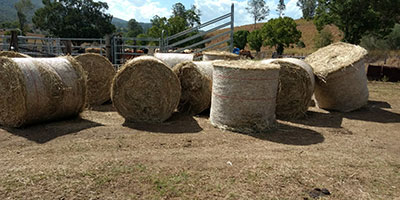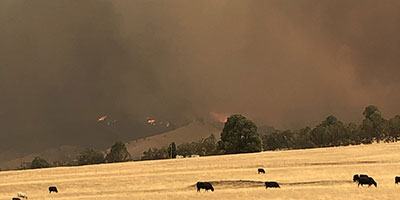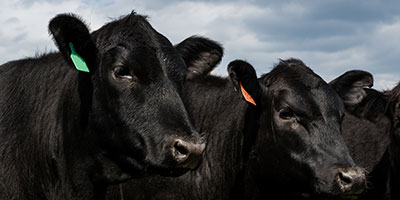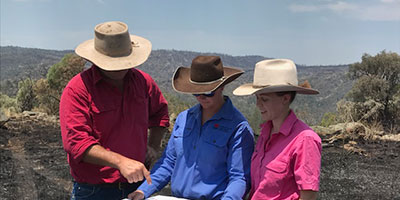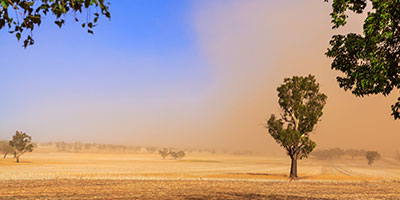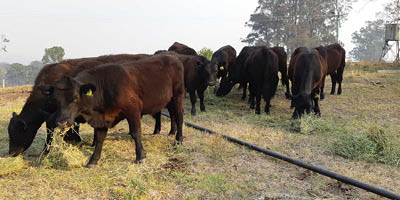Bushfire recovery
Recovery following bushfire may be a long process. There are various activities land managers can do to assist in the recovery of their property following a bushfire.
Water
Water is the first priority after a fire. We recommend you:
- Inspect your on-farm water infrastructure:
- Examine your infrastructure, including tanks, troughs, pumps, and poly pipes. These elements may have suffered damage due to the fire.
- After the fire, inspect foot valves for the presence of ash and silt, and continue to monitor them over time.
- Check your dam and groundwater levels:
- It's possible that the fire or the water used to combat it has led to a significant decrease in dam and groundwater levels.
- Check for water contamination:
- Be aware that materials such as ash and soil can be carried into dams, creeks, and rivers from scorched paddocks.
- Water contamination may result in issues such as algae blooms, water degradation, and challenges for livestock accessing clean water.
- High sediment loads reduce oxygen levels in the water. Sediments can suffocate aquatic animals with a fine layer of silt which coat their gills and other breathing structures.
- Maintain or improve water quality:
- Water quantity and quality are extremely important; water should be cool and clean.
- If you have smaller troughs, they are at a higher risk of heating up. If feasible, consider installing shade structures or arranging an alternative water source.
- Regularly clean troughs to prevent the development of dust films that can affect water consumption.
- Protect dams and watercourses from runoff after a fire using sediment traps to filter runoff. Small hay bales pegged down with droppers, or chicken wire anchored across the drainage line or coir logs can be effective.
- In the long-term, revegetation along waterways will help buffer temperature extremes and sediment loads entering streams.
- Understand water requirements for your livestock:
- See the following table as a guide for average water requirements for stock. Please note these are averages and livestock may consume double their usual water intake during a heatwave.
| Stock type | Consumption per head/per day (L) |
|---|---|
| Sheep | Up to 4 |
| Adult Dry Sheep | Up to 6 |
| Ewes with lambs | Up to 10 |
| Lactating cows | Up to 100 |
| Weaner cattle | Up to 50 |
| Yearling cattle | Up to 80 |
| Horses | Up to 50 |
Feed
Livestock feeding is a significant consideration following fire. The quantity and type of feed required will depend on numerous factors, such as the nutritional content of the feed (specifically, energy and protein levels), the size, type, condition, stage of pregnancy or lactation of the livestock, the availability of facilities or equipment, the past feeding history of the livestock, and the extent to which the livestock have been impacted by the fire.
Keep the following in mind when feeding livestock after fire:
- Feed tools:
- NSW DPI’s Feed Cost Calculator is a very useful tool to assist producers calculate and compare protein, energy and other components for different mixes of livestock feeds.
- There is also a Drought Feed calculator app to help with feeding decisions and working out different livestock requirements.
- Feeding grain and hay:
- Ensure you are feeding high quality hay. Good quality hay should have a sweet and pleasant smell and should be green rather than yellow or brown. We recommend getting a feed test done to be sure of feed quality.
- Before introducing grain, introduce hay first to minimise acidosis
- When feeding grain, it is important to feed limestone at 1 ½ per cent and salt at ½ per cent
- Cattle and sheep:
- Refer to the Cattle and Sheep feed options: Minimum weight (kg) per day ‘as fed’ tables below for specific measurements
- Lactating cows and ewes need at least 20% hay to maintain milk production
- Young cattle need a minimum level of 9% protein for growth
- Rapidly growing sheep and lambs, ewes in late pregnancy and lactation have higher requirements for energy and protein. A protein supplement will be required in some situations for growth and maintenance
- It would be best if young cattle and lambs are fed for production
- Stock containment areas:
Utilise a stock containment area (carefully selected, small, fenced section of the property) as a temporary holding area to:
- keep stock off burnt ground
- feed and water livestock
- monitor animal health
- minimise the potential of ash, organic matter and soil washing into dams and waterways and causing water quality problems.
Cattle feed options: Minimum weight (kg) per day ‘as fed’
| Stock type | Grain only (12ME) | Hay only (8.5ME) | 50:50 Grain:Hay | 80:20 Grain:Hay | Silage (35% dry matter 9ME) | Expected weight gain/day |
|---|---|---|---|---|---|---|
| Weaner (250 kg) | 3.5 | 5.5 | 4.5 | 4 | 14 | 0.25 kg |
| Yearling (330 kg) | 4.4 | 7 | 5.5 | 4.8 | 16.8 | 0.25 kg |
| Adult dry stock (500 kg) | 5 | 7.8 | 6.2 | 5.5 | 18.6 | Nil |
| Breeder, late pregnancy (500 kg) | 6.1 | 9.3 | 7.4 | 6.6 | 22.4 | Nil |
| Breeder, lactating (500 kg) | Not suitable | 12.5 | 9.9 | 8.8 | 29.8 | Nil |
Sheep feed options: Minimum weight (kg) per day ‘as fed’
| Stock type | Grain only (12ME) | Hay only (8.5ME) | 50:50 Grain:Hay | 80:20 Grain:Hay | Silage (35% dry matter 9ME) | Expected weight gain/day |
|---|---|---|---|---|---|---|
| Weaner (20 kg) | 0.62 | 1.08 | 0.80 | 0.68 | 2.54 | 0.1 kg |
| Weaner (30 kg) | 0.76 | 1.32 | 0.95 | 0.84 | 3.09 | 0.1 kg |
| Adult dry stock (50 kg) | 0.65 | 0.99 | 0.79 | 0.7 | 2.37 | Nil |
| Ewes, last 6 weeks of pregnancy (50kg) | 1.1 | 1.68 | 1.33 | 1.18 | 4.02 | Nil |
| Ewe and Lamb to one month (50kg) | Not suitable | 2.46 | 1.96 | 1.74 | 5.91 | Nil |
| Ewe and Lamb to 2 or 3 months (50kg) | Not suitable | 1.77 | 1.41 | 1.25 | 4.26 | Nil |
Further information and resources
Agistment
Agistment is a good option for livestock and producers affected by fires. There are some considerations to be made before sending stock on agistment.
- Animal health:
- Livestock originating from fire-affected areas need more frequent monitoring compared to those unaffected by fire. Past experiences have shown that livestock from such areas may face various health challenges, potentially requiring subsequent veterinary care.
- Consider potential health concerns when relocating your livestock to the target area and district, such as OJD (Ovine Johne's Disease), BJD (Bovine Johne's Disease), footrot, and drench resistance. Consult local veterinarians to identify any specific considerations or livestock types that should not be introduced, especially if they are pregnant.
- Feed:
- Change of feed may potentially cause health issues, and a 5-in-1 vaccination may become necessary. Consult with a veterinarian about this if needed.
- Chat to locals to learn about unusual grass species in the area. Some of these grasses may appear healthy but offer poor nutritional value, meaning stock will need supplementary feeding to use these grasses. Examples include Coolatai grass, African love grass, and Blady grass.
- Landholder responsibilities:
- Establish clear responsibilities for stock management, water supply, and feed provision while your livestock are on the agisted property.
- Returning home:
- Prior to bringing your livestock back to your property, consider the contaminants they might carry, such as worms, diseases, and grass seeds. Allocate a quarantine paddock for this purpose.
For more information on this topic, read the agistment guidelines primefact.
Erosion
Erosion risk increases after a fire due to the lack of groundcover to stabilise the soil and slow down the speed of runoff. Intense burns may also cause soils to repel rather than absorb water, leading to increased runoff and erosion.
Some activities to reduce the risk of erosion and promote the recovery of land include:
- Removing grazing pressure
- Minimising soil disturbance by reducing vehicle traffic over the burnt land
- Slowing the flow of water by using sediment traps such as logs, smaller branches, mulch, hay bales, coir logs
- Encouraging natural regeneration of native vegetation and pasture
- Prioritising works to protect the most valuable assets first.
Weeds
The risk of weed invasion increases after a fire.
Although fire can promote weed growth, it can also provide access to weed infestations. Try to control post-fire germinated weeds before they set seed. Prioritise weed removal to areas where long-lasting weeds are threatening valuable sites and areas of established weeds.
Disturbed areas after a bushfire are particularly vulnerable to weed incursions. Ensure that vehicles and equipment used by contractors and advisors are clean and weed-free.
Ensure fodder is weed-free. Feed-out in a confined area away from drainage lines to reduce the likelihood of weeds being spread.
Building up stock numbers when recovering from a fire is an activity that can introduce weeds. Quarantine new stock in a containment area or paddock to allow weed seed to pass through the animal. Check for weed seed in fleece and continue to check for weeds in areas with new stock.
Pest animals
The months after a bushfire are among the best times to control feral animals.
Fox, wild dog and cat control may be vital to protect animals that survived the bushfire. Control of rabbits, hares, goats, deer, feral horses will help reduce grazing pressure on regenerating plants.
Rabbit warrens and fox dens may be exposed. There is an opportunity to clean up warrens and dens with debris and damaged fences.
Wildlife habitat
Only remove burnt material that is a health and safety hazard, such as dead trees that could fall and threaten people’s safety, buildings or fence lines.
Leave any fallen timber where it falls in remnant areas. Fallen wood is the natural way fauna habitat is created and is an essential refuge for wildlife post-fire. Burnt trash and undisturbed ash beds also offer some protection from wind and water erosion following fires and provide better conditions for germination and early regrowth.
In some cases, it may be helpful to provide artificial shelter such as nest boxes for birds and mammals, tin sheets and tiles for reptiles, and chicken wire and shade-cloth shelters for ground-dwelling animals and birds to give them a safe habitat from invasive predators (such as foxes and cats) and nesting areas.
Native vegetation regeneration and revegetation
Usually, the best option is to leave native vegetation to regenerate naturally.
Priority should be given to sensitive weed control to encourage natural regeneration, taking care to prevent any off-target damage to native plants.
Assess the total loss or recovery of native vegetation in spring-summer following the fire. In certain circumstances, supplementary planting with tubestock or direct seeding with native seed can be useful.
Regeneration of revegetation plantings largely depends on the age of the planting and species. Where immature plants have burnt, replanting may be necessary.
Further information and resources
Video series resources
- Recovering from bushfire: A Tarago farmer's story - YouTube
- Bushfire recovery: Preparing and recovering from bushfire (Jane Bennett) - YouTube
- Bushfire recovery: Stock management advice (Jillian Kelly) - YouTube
- Bushfire recovery: Biosecurity considerations for stock management (Mal Leeson) - YouTube
- Bushfire recovery: Livestock management advice (Brett Littler) - YouTube
- Bushfire recovery through the eyes of a district vet (Jane Bennett) - YouTube
- Bushfire recovery: Importance of a stock feed test (Brett Littler) - YouTube
- Bushfire recovery: Pasture management (1/3) - identifying pasture (Clare Edwards) - YouTube
- Bushfire recovery: Pasture management (2/3) - understanding fire damage (Clare Edwards) - YouTube
- Bushfire recovery: Pasture management (3/3) - identifying germination - YouTube
- Bushfire recovery through the eyes of a biosecurity officer (Mal Leeson) - YouTube
- Bushfire recovery: What is the role of a district vet? (Jillian Kelly) - YouTube
- Bushfire recovery through the eyes of a senior land services officer (Brett Littler) - YouTube
- Bushfire recovery: What is the role of a biosecurity officer? (Mal Leeson) - YouTube.
Adapted from content written by Senior Land Services Officer, Brett Littler.
